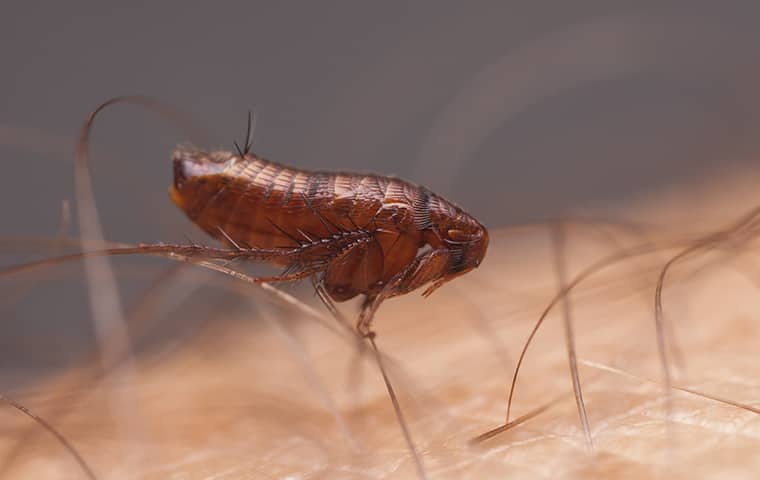
Flea and Tick Identification & Prevention
What are fleas and ticks?
Fleas and ticks are types of external parasitic pests that feed on the blood of both people and animals. Fleas are about the size of a speck of dirt and have hard, flat bodies that are shiny and dark reddish-brown in color. Fleas are wingless, but have mighty back legs that allow them to jump quickly out of the way to danger. Fleas also have specialized spines on their mouth, back, and legs to prevent them from falling off of their hosts. Ticks have oval-shaped bodies. They use their specialized mouthparts to grasp and pierce the skin of their victims and insert a feeding tube to suck out the blood.
Some of the most common species of ticks living in the Kansas City Metro area are American dog, black-legged, brown dog, and lone star ticks.

Are fleas and ticks dangerous?
Both fleas and ticks are dangerous and are capable of spreading diseases and parasites to both people and animals. Fleas are responsible for transmitting the parasitic tapeworm. Also, their saliva can create an allergic reaction in some people and pets that causes severe itchy dermatitis. Itchy dermatitis can lead to a secondary infection that requires medical attention. Pets that are heavily infested with ticks can become severely anemic. Ticks are responsible for spreading a wide range of diseases including Lyme disease, Rocky Mountain spotted fever, tularemia, and ehrlichiosis.
Why do I have a flea and tick problem?
People often come into contact with both fleas and ticks after they are introduced onto properties by wild animals like skunks, squirrels, deer, raccoons, foxes, and opossums. Once on your property, they remain until a new host passes by that they can attach themselves to and begin feeding on. Unfortunately, the new host could be you, your kids, or pets, who then introduce these biting blood-feeders into your home. Additionally, you could come into contact with either ticks or fleas in public places like campgrounds, parks, dog parks, vet offices, and grooming facilities.
-
Highly Referral BasedA large quantity of our business comes from referrals from other satisfied customers.
-
Customer Care FocusedWe offer our services with NO CONTRACTS, so you don't have to worry about getting locked into a service plan. Our word is our contract!
-
Trained & Certified Technicians
We use only the most advanced, modern methods and Integrated Pest Management (IPM) strategies to protect your home.
-
Over 50 Years of ExperienceWe are the largest independent, non-franchise pest control company in Kansas.
-
Family Owned & OperatedOur three generations practice their family values into the their every day work days!
-
Quality Products & Solutions
We offer quality service at a reasonable price, satisfaction guaranteed!

Hear From Our Happy Customers
Serving Overland Park, KS Since 1966
-
"Zero issues with bugs."Jim is exceptional at communication and timeliness- Brian P.
-
"Thank you so much, Augustine!"Jim was quick to capture the vole and the problem was solved.- Brenda M.
-
"Will definitely call on Augustine again."They scheduled us very quickly.- Dottie B.
-
"Can’t recommend them highly enough."We have used Augustine for 7 years and have been very pleased.- Paula S.
-
"Highly recommend!"My tech, Lee is professional, well-groomed, on time, friendly and is an effective communicator.- Michelle G.
-
"Helpful and informative service."Jim is awesome and very helpful and informative.- Hannah P.
-
"I wouldn't change my service provider at all!"They are professional and always update me when it's time for a service.- Samantha O.
-
"Augustine Exterminators is a great company."If Google allowed more than 5 stars I would give it!!- Gregg H.
Where will I find fleas and ticks?
Ticks live outside in areas of tall grasses, dense vegetation, in ditches, along ponds, or the edges of woods. Most species of ticks are unable to survive indoors. The exception is the brown dog tick. They don't require moist soil for their eggs to develop, which means they can complete their entire life-cycle indoors and become a problem inside of any home. Fleas live outside in shady, moist, or sandy areas but commonly find their way into a home on pets or people's clothing. Adult fleas spend most of their lives on a host, laying eggs in the fur.
Fleas can also find their way into homes inside of used furniture or rugs that are already infested with their eggs, larvae, or adults. Fleas can live successfully inside and are prolific breeders; meaning just a few fleas can quickly turn into hundreds or thousands. Fleas thrive in warm, humid climates and at temperatures of 65 to 80 degrees Fahrenheit.
How do I get rid of fleas and ticks?
To eliminate fleas and ticks from your home or property, partner with a professional pest control expert. At Augustine Exterminators we provide the advanced modern methods needed to solve your unique pest problems and prevent future ones. Our trained and certified specialists offer homeowners effective and affordable flea and tick control services. To learn more about the residential and commercial pest control services we provide throughout Kansas City Metro, call Augustine Exterminators today!

-
 Our Services
Our Services -
 Customer Reviews
Customer Reviews -
 Pest Library
Pest Library -
 Resources
Resources




.2403080945301.png)

.2403080945295.png)
.2403080945297.png)



